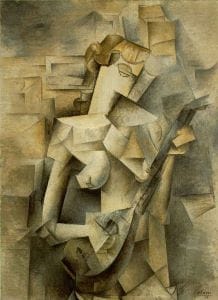Mosaic (II)

Today, the screen is connected across the planet receiving and sending instantaneous information and perspectives from which, tactility, the receiver is completely removed. “Our highly literate societies are at a loss as they encounter the new structures of opinion and feeling that result from instant and global information. They are still in the grip of "points of view" and of habits of dealing with things one at a time. Such habits are quite crippling in any electric structure of information movement, yet they could be controlled if we recognized whence they had been acquired. But literate society thinks of its artificial visual bias as a thing natural and innate.”(Mc)
In general, McLuhan is absolutely correct in understanding this fundamental shift in perspective. One can certainly argue and should about what it means. Sixty years on, the screen has become more ubiquitous, instantaneous, and for all intents and purposes, infinite in communication and information quantity. We have little understanding how this technology is shaping us both as individuals and society, most especially as we've historically disregarded technology's shaping force. Literacy and linearity are still foundational to the organization of society and essential to the creation of technology. Yet as a means of communication, literacy is becoming ever more specialized, irrelevant in many ways to shaping the greater social whole where the mosaic created by the networked screen increasingly dominates. “Scarcely a single area of established relationships, from home and church to school and market, has not been profoundly disturbed in its pattern and texture.”(Mc)
Paradoxically, if events continue as currently established, literacy will once again become largely a tool of a small elite just as it is was before the printing press. An elite using the tool of literacy to shape and control technology, the environment of the electric mosaic, through which the vast majority communicate and interact.
Feedback
In an electric system with the ability to send and receive instantaneous messages simultaneously from numerous sources, linear organization becomes problematic. Linearity is even more greatly challenged when an electric system incorporates feedback. “Anybody who begins to examine the pattern of automation finds that perfecting the individual machine by making it automatic involves 'feedback.' That means introducing an information loop or circuit, where before there had been merely a one way flow or mechanical sequence.” (Mc) Wiener was essential in developing the idea of feedback, defined as, “For any machine subject to a varied external environment, in order to act effectively it is necessary that information concerning the results of its own action be furnished to it as part of the information on which it must continue to act.”(W)
In Cybernetics, Wiener notes, “The first significant paper on feedback mechanisms is an article on governors, which was published by Clerk Maxwell in 1868, and that governor is derived from a Latin corruption of χυβερνήτης (cybernetic). We also wish to refer to the fact that the steering engines of a ship are indeed one of the earliest and best-developed forms of feedback mechanisms.” Wiener's understanding was seminal in understanding what feedback would mean for electric and compute technologies.
The process of feedback complicates the linearity of industrial development, fostering the creation of the non-linear information technology mosaic. “Feedback is the end of the lineality that came into the Western world with the alphabet and the continuous forms of Euclidean space. Feedback or dialogue between the mechanism and its environment brings a further weaving of individual machines into a galaxy of such machines throughout the entire plant. There follows a still further weaving of individual plants and factories into the entire industrial matrix of materials and services of a culture. Naturally, this last stage encounters the entire world of policy, since to deal with the whole industrial complex as an organic system affects employment, security, education, and polities, demanding full understanding in advance of coming structural change. There is no room for witless assumptions and subliminal factors in such electrical and instant organizations.”(Mc)
“It is certainly true that the social system is an organization like the individual, that it is bound together by a system of communication, and that it has a dynamics in which circular processes of a feedback nature play an important part. .…This complex of behavior is ignored by the average man, and in particular does not play the role that it should in our habitual analysis of society.” (W Cy) This is a terribly important and relative point for our era. Our associations — social organization, corporations, and government — are all overwhelmingly one directionally linear. This is not coincidence, most social order has roots deep in linear text organization back to the founding of the phonetic alphabet. Reforming societal associations to not simply accept feedback, but be shaped by it, is the most fundamental political reform of the 21st century.
Of course, the question of designing feedback into social systems today immediately raises the question of incorporating the machine. In understanding the roles of the machine in this sense, we need to understand the process of feedback in machine automation. Wiener writes of the compute machine in 1950,
“For a large range of computational work, they have shown themselves vastly more rapid and vastly more accurate than the human computer. Their speed has long since reached such a level that any intermediate human intervention in their work is out of the question. Thus they offer the same need to replace human capacities by machine capacities as those which we found in the anti-aircraft computer. The parts of the machine must speak to one another through an appropriate language, without speaking to any person or listening to any person, except in the terminal and initial stages of the process. Here again we have an element which has contributed to the general acceptance of the extension to machines of the idea of communication.”(W)
In the 75 years since, this process increased exponentially. Compute technology has become ever more ubiquitous in every aspect of society. The technology ever more proficient in communicating with itself. Wiener understood very well and profoundly cautioned against simplistically thinking of the machine removing the human element as automatically advantageous:
“Any machine constructed for the purpose of making decisions, if it does not possess the power of learning, will be completely literal-minded. Woe to us if we let it decide our conduct, unless we have previously examined the laws of its action, and know fully that its conduct will be carried out on principles acceptable to us! On the other hand, the machine like the djinnee (genie), which can learn and can make decisions on the basis of its learning, will in no way be obliged to make such decisions as we should have made, or as will be acceptable to us. For the man who is not aware of this, to throw the problem of his responsibility on the machine, whether it can learn or not, is to cast his responsibility to the winds, and to find it coming back seated on the whirlwind.”(W)
If the machines are purely in the control of a handful of corporations, the entire structure will be designed to their advantage.
The Job Versus the Role
Both Wiener and McLuhan saw the dawn of the era of automation and asked the question, what happens to the job? “Such is also the harsh logic of industrial automation. All that we had previously achieved mechanically by great exertion and coordination can now be done electrically without effort. Hence the specter of joblessness and propertylessness in the electric age. Wealth and work become information factors, and totally new structures are needed to run a business or relate it to social needs and markets.” (Mc)
Certainly such technological transformation is not unprecedented. According to the BLS, a century and half ago, over 60% of the American populous was engaged directly in farming, today that number is 1.5%. In the 1950s, at the height of American industry, a third of the population was directly involved in manufacturing, today that number is less than 8%. In the last half-century, wealth has been violently transferred to the Tech sector, yet it employs less than 2% of the workforce. To this point, Tech has greatly been valued for the labor it displaces.
“Thus, with automation, for example, the new patterns of human association tend to eliminate jobs, it is true. That is the negative result. Positively, automation creates roles for people, which is to say depth of involvement in their work and human association that our preceding mechanical technology had destroyed. Many people would be disposed to say that it was not the machine, but what one did with the machine, that was its meaning or message. In terms of the ways in which the machine altered our relations to one another and to ourselves, it mattered not in the least whether it turned out cornflakes or Cadillacs.”(Mc)
McLuhan's point, his refutation of Sarnoff, is essential to any understanding of the politics of technology. Technology's adoption, no matter what technology, no matter what its content, asserts political aspects in and of itself. The political structures built atop and through this technology need to take into account a technology's politics to effectively design the greater political environment. For example, America's Agrarian Era government institutions changed not at all with American industrialization. Whatever democratic character the institutions originally had were largely lost. The 19th century community associations built around agriculture, that Tocqueville understood as essential elements of democracy in America, largely disappeared by the middle of the 2Oth century, replaced by the forceful organization of the undemocratic industrial corporation and broadcast media.
At it's foundation, automation, the process of feedback, is an information process, that can, for certain people, require a “depth of involvement in their work and human association that our preceding mechanical technology had destroyed.” However, the overwhelming number of jobs since created have been of no greater depth, in fact the economy, overwhelming created “service” jobs, which in their responsibilities – food, entertainment, and care – a couple hundred years ago would have been designated servants work. One characteristic all servants share is they don't decide. The structural change in power that occurred with electric and information technologies has not been an empowering of the individual, but ever greater control by ever fewer massive corporations.
McLuhan writes, "'Work,' however, does not exist in a nonliterate world. The primitive hunter or fisherman did no work, any more than does the poet, painter, or thinker of today. Where the whole man is involved there is no work. Work begins with the division of labor and the specialization of functions and tasks in sedentary, agricultural communities. In the computer age we are once more totally involved in our roles. In the electric age the 'job of work ' yields to dedication and commitment, as in the tribe.”(Mc)
The thing McLuhan misses, and its from ignoring political organization, is work has been a social construct created by the dominant power entities of each era. A switch from the job to roles, requires a complete restructuring of existing associations, corporations, and government, in order to value the role and not the job. This next generation of information technology marketed as AI will facilitate not just the automation of blue collar jobs, but even more quickly many designated white collar jobs. “Let us remember that the automatic machine, whatever we think of any feelings it may have or may not have, is the precise economic equivalent of slave labor. Any labor which competes with slave labor must accept the economic conditions of slave labor.”(W)
The role, opposed to the job requires organization that values participation, and most especially participation in decision making. “The village had institutionalized all human functions in forms of low intensity. In this mild form everyone could play many roles. Participation was high, and organization was low. This is the formula for stability in any type of organization.”(Mc) This is an exceptional point, the greater the participation, the lesser necessity for strict organization, either by law, the assembly line, or bureaucratic centralized order of the corporation or government. Social order, stability, homeostasis can be provided through active participation, not just by stringent rules. Such order is not only anathema to centralized power, but requires a great relearning and redefining of the roles of all involved.
“In the age of instant information man ends his job of fragmented specializing and assumes the role of information gathering. Today information gathering resumes the inclusive concept of "culture," exactly as the primitive food-gatherer worked in complete equilibrium with his entire environment. Our quarry now, in this new nomadic and "work-less world, is knowledge and insight into the creative processes of life and society.(Mc)
Looking at the culture of the internet, McLuhan was absolutely correct. People now spend hours every day “information gathering.” Yet, this is not a participation in creation, actively organizing, or decision making, but mostly that of passive consumer and the animal lost in the hypnotizing light of the screen. In order for information gathering to be effectively incorporated into participatory roles requires a reorganization, a redesign of established institutions and processes making them controlled by participation. There is no talk of this. For the great mass of humanity, the screen attached to infinite information becomes nothing more than an ever more dominant diversion.

